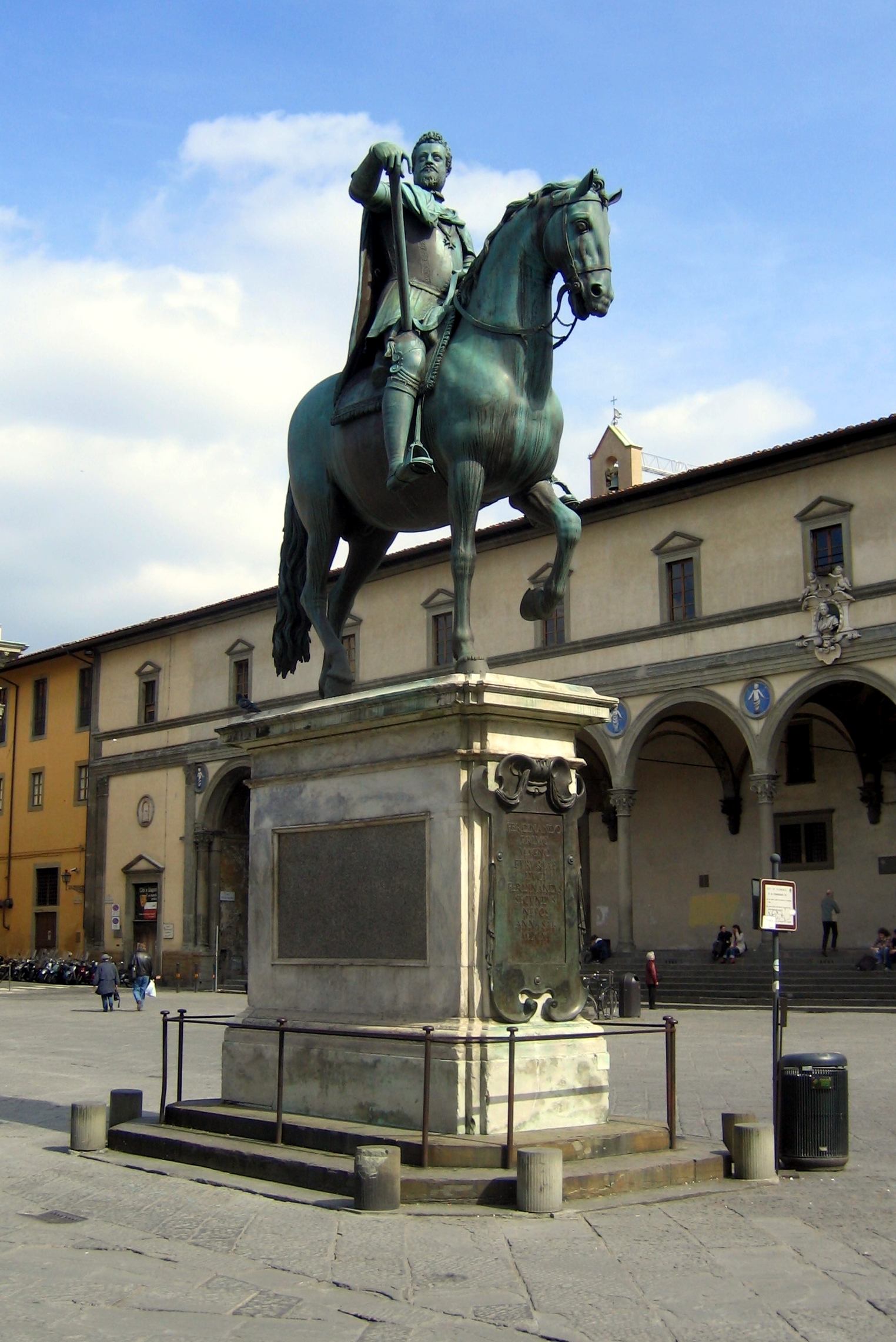Equestrian statue of Ferdinando I on:
[Wikipedia]
[Google]
[Amazon]
 The Equestrian Monument of Ferdinando I is a bronze equestrian statue by
The Equestrian Monument of Ferdinando I is a bronze equestrian statue by
 Grandduke Ferdinand wears armour emblazoned on the chest with the Cross of Santo Stefano, an equestrian Order established by Cosimo the elder. It is said the statue was cast with cannons taken from the Turks by the Knights of Santo Stefano.
Grandduke Ferdinand wears armour emblazoned on the chest with the Cross of Santo Stefano, an equestrian Order established by Cosimo the elder. It is said the statue was cast with cannons taken from the Turks by the Knights of Santo Stefano.Corografia dell'Italia
Volume 3, by Giovanni B. Rampoldi, page 1085. Flanking the statue some yards to the rear of the horse are two mannerist fountains with marine gargoyles, the
 The Equestrian Monument of Ferdinando I is a bronze equestrian statue by
The Equestrian Monument of Ferdinando I is a bronze equestrian statue by Giambologna
Giambologna (1529 – 13 August 1608), also known as Jean de Boulogne (French), Jehan Boulongne (Flemish) and Giovanni da Bologna (Italian), was the last significant Italian Renaissance sculptor, with a large workshop producing large and small ...
, executed in 1602–1607, and erected in 1608 in the Piazza of the Annunziata in Florence
Florence ( ; it, Firenze ) is a city in Central Italy and the capital city of the Tuscany region. It is the most populated city in Tuscany, with 383,083 inhabitants in 2016, and over 1,520,000 in its metropolitan area.Bilancio demografico an ...
, region of Tuscany
Tuscany ( ; it, Toscana ) is a Regions of Italy, region in central Italy with an area of about and a population of about 3.8 million inhabitants. The regional capital is Florence (''Firenze'').
Tuscany is known for its landscapes, history, art ...
, Italy
Italy ( it, Italia ), officially the Italian Republic, ) or the Republic of Italy, is a country in Southern Europe. It is located in the middle of the Mediterranean Sea, and its territory largely coincides with the homonymous geographical re ...
.
History
The monument was commissioned byCosimo II
Cosimo II de' Medici (12 May 1590 – 28 February 1621) was Grand Duke of Tuscany from 1609 until his death. He was the elder son of Ferdinando I de' Medici, Grand Duke of Tuscany, and Christina of Lorraine.
For the majority of his twelve-ye ...
, son of Ferdinando I de' Medici, Grand Duke of Tuscany, from an elder Giambologna
Giambologna (1529 – 13 August 1608), also known as Jean de Boulogne (French), Jehan Boulongne (Flemish) and Giovanni da Bologna (Italian), was the last significant Italian Renaissance sculptor, with a large workshop producing large and small ...
, and was meant to be modeled on the similar Equestrian statue of Cosimo I
The Equestrian Monument of Cosimo I is a bronze equestrian statue executed by Giambologna from 1587 to 1594, and erected in 1594 in the Piazza della Signoria in Florence, region of Tuscany, Italy.
History
This statue follows the Classical Roman ...
that stands in the Piazza della Signoria
Piazza della Signoria () is a w-shaped square in front of the Palazzo Vecchio in Florence, Italy. It was named after the Palazzo della Signoria, also called Palazzo Vecchio. It is the main point of the origin and history of the Florentine Republ ...
.
This project was mainly completed by his pupil Pietro Tacca, and the statue was cast in 1602 and inaugurated at the site in 1608 during the festivities celebrating the marriage of Prince Cosimo II with Maria Maddalena d'Austria.
Volume 3, by Giovanni B. Rampoldi, page 1085. Flanking the statue some yards to the rear of the horse are two mannerist fountains with marine gargoyles, the
Fontana dei mostri marini
The two fontane dei mostri marini ("sea monster fountains") are located in the Santissima Annunziata plaza in the Italian city of Florence.
History
The two fountains were placed in 1641 at the sides of the Santissima Annunziata plaza, having bee ...
, also created by Tacca though initially intended to be placed at the statue of Ferdinand in Livorno
Livorno () is a port city on the Ligurian Sea on the western coast of Tuscany, Italy. It is the capital of the Province of Livorno, having a population of 158,493 residents in December 2017. It is traditionally known in English as Leghorn (pronou ...
.
References
{{DEFAULTSORT:Equestrian Monument Ferdinando Equestrian statues in Italy Monuments and memorials in Florence Bronze sculptures in Florence Outdoor sculptures in Florence Sculptures by Giambologna 1600s sculptures Statues of monarchs Sculptures of men in Italy